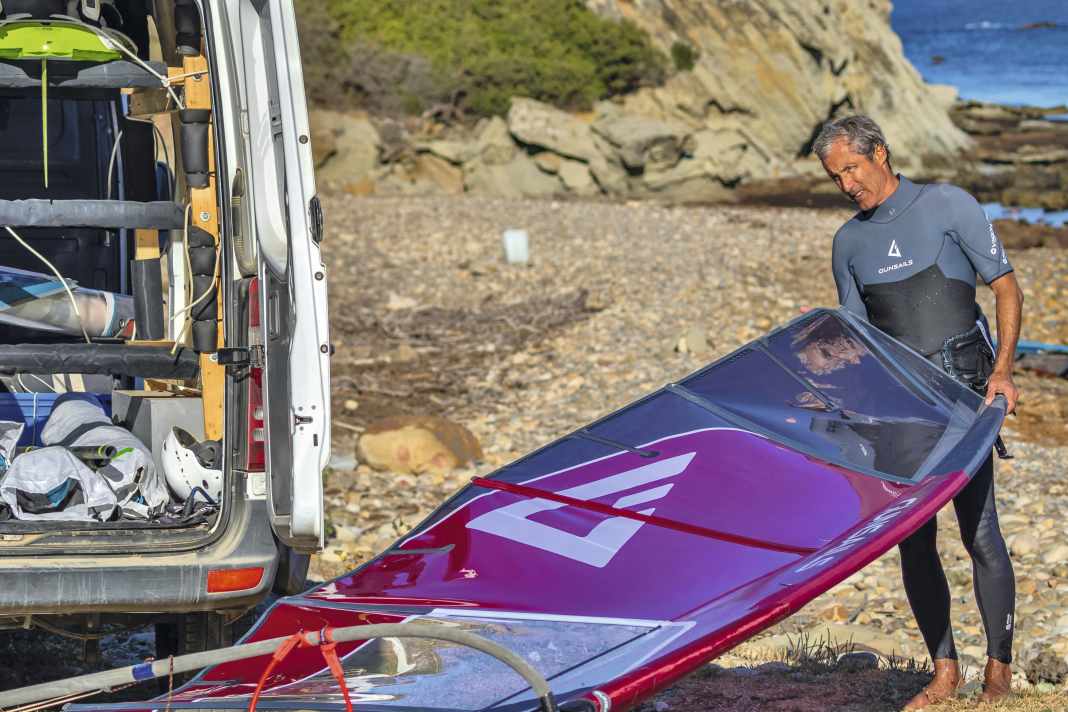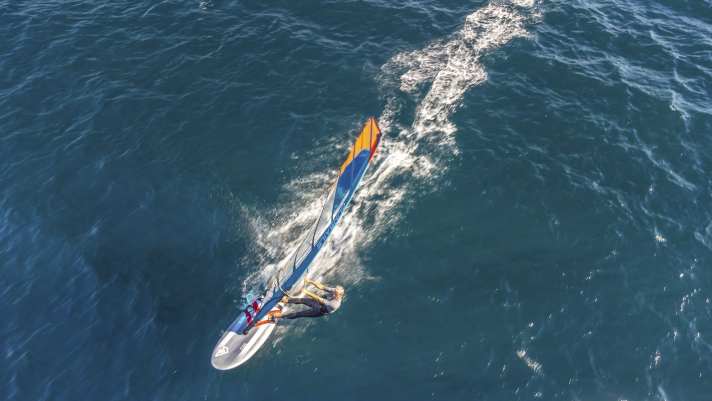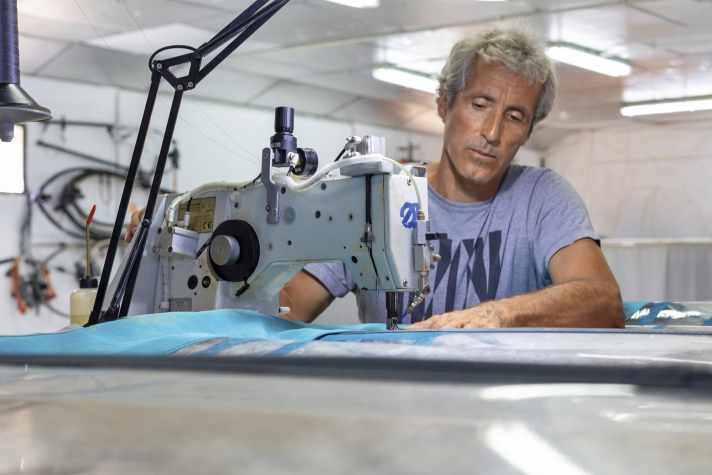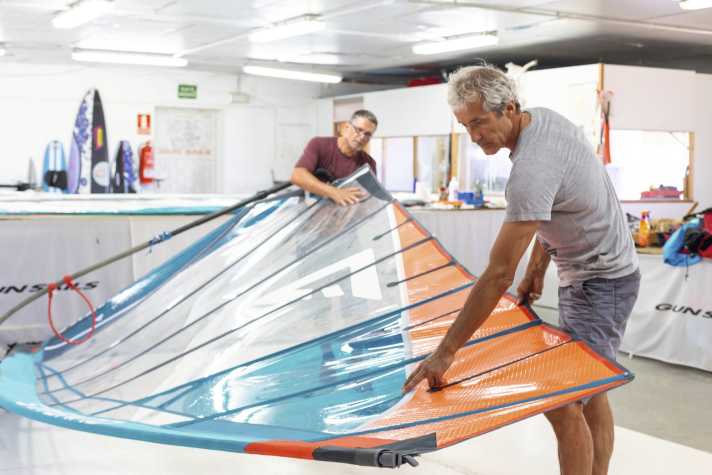





Could there be a better job than being a test rider for one of the big windsurfing brands? You get to test the latest and greatest equipment all the time and put it through its paces all year round in a first-class surfing area. A fantastic idea, isn't it? But of course the real life of a head tester at a sailing brand looks a little different. We spoke to Sebastian Kornum, who tests NeilPryde sails for sailmaker Robert Stroj, and Phillipe Vigneron, who supports Renato Morlotti in the development of the Gun sails, about their "tough" day-to-day work.
Phillipe Vigneron - Chief tester at GunSails
Philippe Vigneron grew up in the Vendée near the French Atlantic coast. His parents were already windsurfing fanatics, as he tells us, and also got him into windsurfing. Today, he is the head tester for GunSails sail development in Tarifa. We often catch him via WhatsApp video call when he's in the car and on his way to the water or when he can just look at the water - still with his typical lightness of touch: "It's hitting over 40 knots here right now!"

Philippe, your father made your first sail for you!
Yes, my father cut a sail smaller because I was too young to catch up with a bigger rig. As a young boy, I needed a sail that was more manageable for me, which I could then use to make good progress on the water.
How did you become head tester at GunSails in Tarifa?
I helped Jochen Krauth and Victor Diaz (both ex-team riders at GunSails, ed.) with testing for a while, then Jochen wanted to work on racing yachts. The door opened for me and GunSails hired me permanently in 2001.
There are so many parameters that you can change on a sail."
How did you start out as a chief sail tester?
In the beginning, I spent a lot of time on the water and tested as many sails as possible. There are so many parameters you can change on a sail, and the problem is not even getting a feel for the characteristics of the sail and whether one sail feels lighter or is more 'stable' than another, but understanding which part of the sail works well or which doesn't. So you need a lot of experience and communication, and really good co-operation with the sail designer. So you need a lot of experience and communication, and a very good co-operation with the sail designer is important to understand how to improve the performance.
You are out on the water testing sails almost every day. How does your own sensitivity to the rig change with the frequency and number of prototypes you test?
Over the years, all my senses concentrate faster and better to pick up details of the sail. I compare and correlate with information from sails and sections that I have already sailed in the past. In the beginning, this work on the water took much longer, we needed many more hours to achieve these results. I also tested a 4.7 sail once and after the test session I rode this sail twice more because I wasn't sure.
What does a normal working day in Tarifa look like for you?
We start at 10am in the loft. When the prototypes are ready and the conditions at the spots are right, I go straight onto the water. When the test is finished, I come back to the loft for a debriefing with Renato. We talk about the changes we need to make, we can make them immediately and then I go back on the water. I'm normally finished by 6 p.m. - in summer, when the wind is thermal, it can be later.

Are you testing the modified prototype on the same day?
Yes, if the wind and water conditions are right, we can test up to two re-cuts a day.
How many prototypes and re-cuts are there per sail size?
It depends on each sail, but we usually make up to four prototypes with up to five re-cuts per size. We can improve a 7.8 GSR with two prototypes, whereas a 5.6 GSR needs six prototypes. Each size has its own luff curve, you can't just project a 9er sail smaller to make an 8er sail! But of course, we also have a time limit with every sail, because every sail has to be put into production with a final cut on a fixed date.
How many prototypes, including re-cuts, have you got your hands on in over 20 years as a tester?
I have no idea! After 20 years, there must be a few thousand that I've tested on the water.
As well as testing on the water, you work with Renato Morlotti in the loft in Facinas, north of Tarifa. What does your work in the loft look like?
I know how to operate a sewing machine or change a mast curve, but Renato is better and faster than me! I work on masts by measuring new masts on a machine, and I grind batten in the same way on a small machine.

How do you divide your working hours between working on the water and in the loft?
I think 30 per cent on the water, 20 per cent looking for good conditions (it's always better to "push" the sail in its full range) and 30 per cent with Renato for re-cuts and debriefing. The rest is spent preparing the equipment.
Do you always have the same impressions during the sailing tests with your test partners?
If a sail works well, everyone agrees. With my 1.83 metres and 75 kilos, the riders I test with have more or less the same physical requirements, which makes testing easier. In cases where the test partners are very light or very heavy, it can be different, because very light riders tend to favour softer sails, for example.
I remember an anecdote about a German speed sailor who wanted to go to Lüderitz in Namibia and wanted a very special sail without a loose leech. I didn't like the feel of the sail, but we did what he wanted.
Do you talk to your test partner during the sail test about the impressions you have just gained?
Good question! No, not normally, because I don't want to influence the other person with their fresh impressions. We discuss this after the test.
You get fresh impressions of the prototypes on the water. You have to speak a common language with your test partner and the sail designer, i.e. articulate your experiences in the same way so that they are understood by the other person, right?
Yes, of course we speak the same language after more than twenty years of working together, and Renato knows exactly what I want to say. When I tell him that the tested sail should generally give more lift, he knows exactly what I mean.

Philippe, who do you talk to more, Renato or your wife?
(Laughs!) Yes, we spend a lot of time together. Even after 22 years, we still want to keep improving ourselves and our sails. We push each other and I couldn't work with a guy if he was "happy". And yes, we talk to each other a lot.
Does it make a difference whether Renato or you test the sails?
Of course, it's better if Renato joins us, because four eyes are even better than two. But Renato knows better how to change the sail.
Other sail designers stand on the beach with binoculars and watch their team riders testing the sails.
Yes, sometimes when I'm out on the water with a slalom sail, he watches how the sail looks and works.
Raising children is like a sail that is never finished!"
What motivates you in your job?
To make our sails even better and to see windsurfers on the water who are happy with our sails and from whom we get great feedback.
What is the best thing about this job?
The process of making our sails even better never ends!
Away from the job. What does a holiday look like for you?
I am married and have children, so we like to spend time together and with our friends. We like to go sailing and windsurfing and spend time outside. Bringing up children is like a sail that is never finished!

